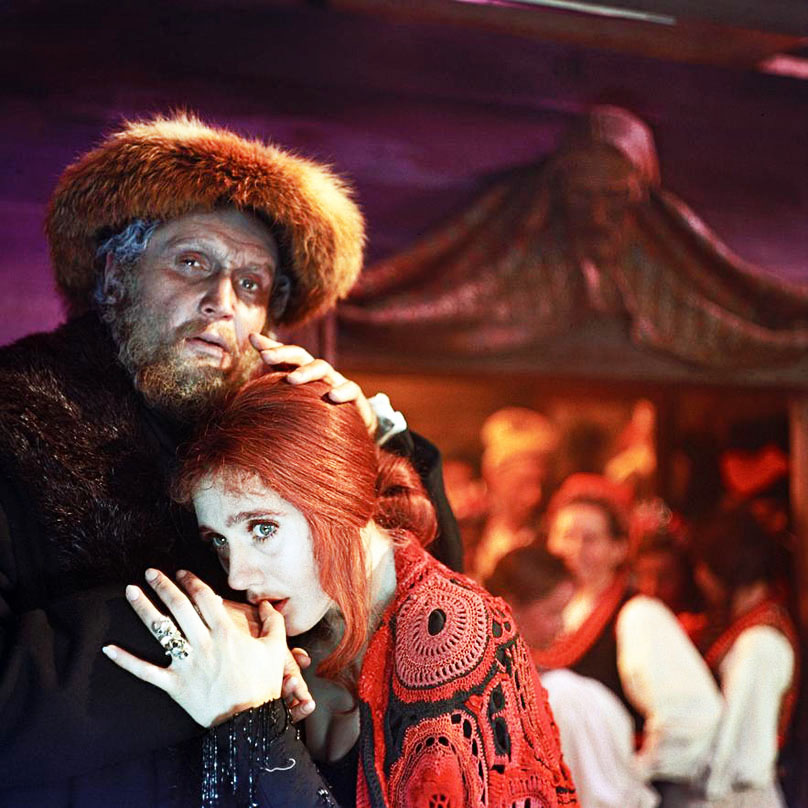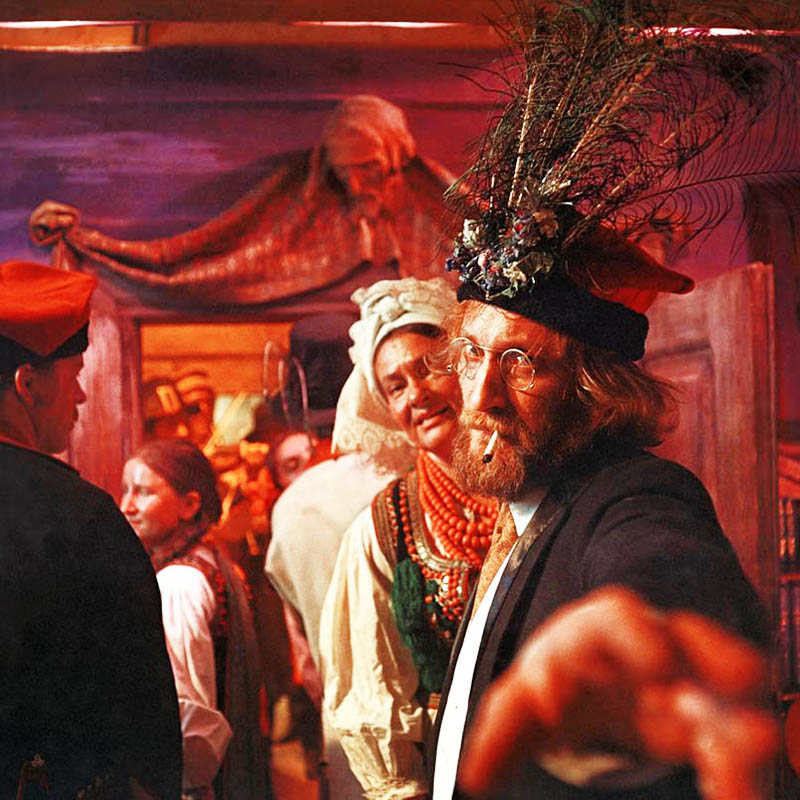By making the decision to adapt Stanisław Wyspiański’s play The Wedding, Andrzej Wajda took a massive risk. This Young Poland play is a deeply poetic piece, inaccessible and full of ambivalent symbols, which should make its translation into the language of film an almost impossible task. Wajda was nevertheless quick to sense the work’s cinematic potential, and was pondering on the possibilities of realizing the project as early as the 60s. The director’s intuition didn’t let him down: the film’s premiere in 1972 triggered opinions that it was film, and not theatre, that constituted the perfect medium for Wyspiański’s masterpiece.
The most challenging part of this endeavour was to overcome the theatrical character of the original. The action of Wyspiański’s play takes place entirely inside of a country cottage, and the characters communicate in verse. Wajda decided to bend this convention somewhat and create the atmosphere of an authentic, bustling wedding on the film set. The first part of the film is an extremely suggestive portrait of a country feast: the dynamic camera meanders among the sweating participants, registering the energetic dances and catching glimpses of conversations.
 Still from The Wedding, dir. Andrzej Wajda, 1972. In the image: Maja Komorowska and Mieczysław Voit, source: Zebra Film Studio/Filmoteka Narodowa / www.fototeka.fn.org.pl
Still from The Wedding, dir. Andrzej Wajda, 1972. In the image: Maja Komorowska and Mieczysław Voit, source: Zebra Film Studio/Filmoteka Narodowa / www.fototeka.fn.org.plThe actors perform their versed exchanges in a fluent, natural fashion, managing to escape a dull literary tone. The wedding of a renowned Kraków-based poet (played by Daniel Olbrychski) to a peasant woman (Ewa Ziętek) becomes an opportunity for an encounter between two different worlds. The guests include, among others: a distinguished poet (Andrzej Łapicki), a conservative journalist (Wojciech Pszoniak), a brawling peasant, Czepiec (Franciszek Pieczka), an alienated Jewish lady Rachela (Maja Komorowska), and the host – an artist who settled down in the countryside (Marek Walczewski). The overexcited groom doesn’t cease to declare his love for the Polish countryside, but nevertheless the harmony of the microcosm portrayed in The Wedding is merely superficial. In reality, the relations between the peasantry and the intelligentsia are filled with conflicts and mutual grudges, such as the memory of the Galician slaughter.
The true difficulty lied in adapting the second act of the play, consisting of a projection of the traumas, insecurities and disappointments eating up early 20th century Polish society. At this point, Wyspiański abandons the quasi-realist convention and conjures a phantasmagorical world, inhabited by allegorical figures and spirits. In Wajda’s interpretation, the appearance of the ‘phantoms’ was justified by the hallucinogenic effects of vodka, which helped those scenes avoid excessive symbolism. Oneiric visions haunt the protagonists, manifesting themselves in various forms: memories, internal monologue and apparitions.
One of the ‘ghostly’ characters that certainly deserves attention is Wernyhora, a mythical bard from Ukraine, summoning the Poles to rise up. The historical perspective employed by Wajda in his take on Wyspiański manifests itself in stylizing the bard after Marshall Józef Piłsudski (a political leader who stood at the front of the 1926 May Coup). By means of this intervention, the authors of the film reference a national revolution that was not even predicted by Wyspiański in 1900, and add a tinge of optimism to the critical portrait of society. This subtle accent doesn’t, however, change the fact that the reality presented in the film is – despite the seemingly festive atmosphere – gloomy and nostalgic. The sorrowful mood can already be sensed in the prologue, in which we see the wedding guests on their way from the church to the party location. The autumnal, grey landscape evokes an aura of stagnation and hopelessness, while the image of the training Austrian soldiers represents the tragic history of Poland.
 Wojciech Pszoniak in The Wedding, dir. Andrzej Wajda, 1972, source: Zebra Film Studio/Filmoteka Narodowa / www.fototeka.fn.org.pl
Wojciech Pszoniak in The Wedding, dir. Andrzej Wajda, 1972, source: Zebra Film Studio/Filmoteka Narodowa / www.fototeka.fn.org.plWhen it comes to the visual concept, The Wedding makes a clear reference to the famous paintings from the period when Wyspiański wrote his play. The film includes frames inspired by Aleksander Gierymski’s Peasant's Coffin, Jan Matejko's Stańczyk and Rejtan, Melancholia by Jacek Malczewski, and some paintings by Wyspiański himself.
Wajda’s collaborators’ contribution to the final effect also deserves attention. The eerie atmosphere of the cottage was achieved largely thanks to the characteristic use of lights and colours, while the emotive flow of the wedding reception scenes is a result of the dynamic cinematography of Witold Sobociński.
Stanisław’s Radwan’s soundtrack, which sets the film’s pace, is also praiseworthy, not to mention the impressive performances by some of the leading Polish actors. By making the best out of the full spectrum of filmic elements, Wajda carried out a masterly translation of Wyspiański’s piece to film. The Wedding remains one of the most important adaptations of a Polish literary classic to this day.
The Wedding (Wesele), Poland 1972. Directed by Andrzej Wajda. Screenplay: Andrzej Kijowski. Cinematography: Witold Sobociński. Music: Stanisław Radwan. Scenography: Tadeusz Wybult. Actors: Marek Walczewski (The Host), Izabela Olszewska (The Hostess), Ewa Ziętek (The Bride), Daniel Olbrychski (The Groom), Marek Perepeczko (Jasiek), Andrzej Łapicki (The Poet), Wojciech Pszoniak (The Journalist), Maja Komorowska (Rachela), Franciszek Pieczka (Czepiec), and others. Production: Zespół Filmowy X. Colour, 102 minutes.
Author: Robert Birkholc, transl. Ania Micińska, May 2014